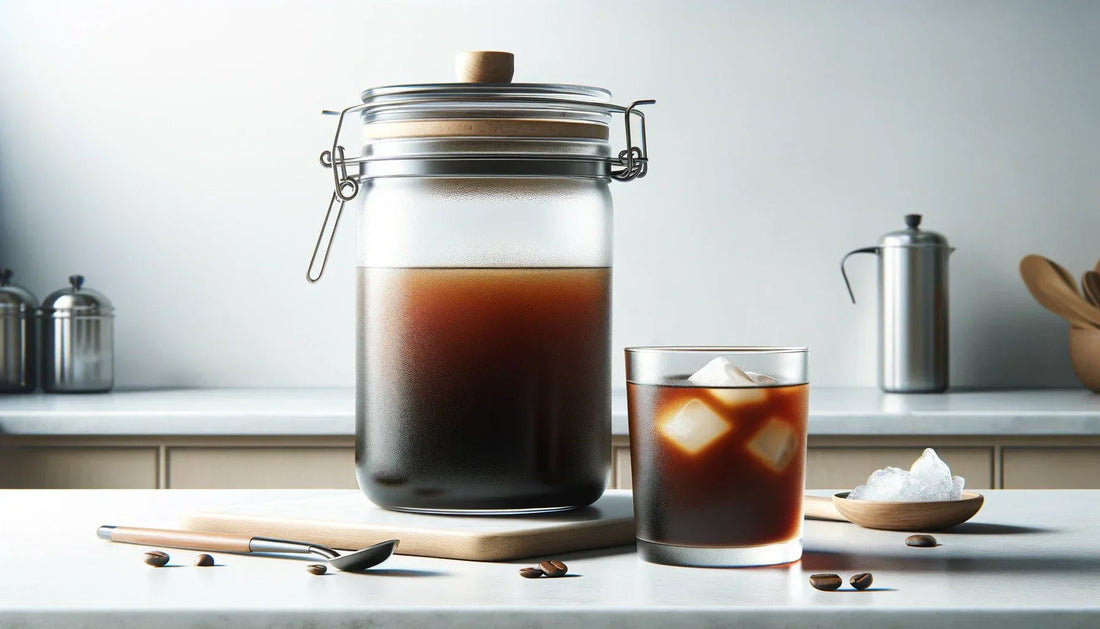Summer is upon us and with it comes the annual curiosity over that interesting and much-loved beverage - The Cold Brew. So without much further ado, here's a complete set of instructions on how to make it. But first, let's discuss what it is, a bit of history and why it's different to brewing hot coffee.
What is Cold Brew Coffee?
Cold brew coffee is a refreshing alternative to hot coffee, perfect for warm weather or when you crave a chilled coffee beverage. Unlike traditional iced coffee, which is brewed hot and then cooled, cold brew is made using cold water, resulting in a less acidic and naturally sweeter drink.
The Ancient Roots and Modern Popularity of Cold Brew Coffee
Cold brew coffee, a trend that has recently swept through cafes worldwide, is often mistaken as a modern innovation. However, its origins are deep-rooted in history. The method of brewing coffee with cold water has been in practice for centuries, with documented use as far back as the 17th century in Japan. This method, revered for its smooth, mild flavour profile, contrasts sharply with the more recent methods of hot brewing that dominate today's coffee culture. Through the years, cold brew has maintained a niche presence, only gaining mainstream popularity in the coffee industry over the last few decades.
The Science Behind Cold Brew Coffee: Understanding Flavour and Compound Extraction
Introduction to Cold Brewing Cold brew coffee utilizes a unique approach, leveraging time instead of heat to extract flavours and compounds from coffee beans. This method significantly impacts the characteristics of the final brew, offering a distinct taste compared to traditional hot brewing methods.
The Role of Temperature in Extraction In traditional hot coffee brewing, heat acts as a catalyst, accelerating the extraction process of flavours and other chemical components from the coffee grounds. This quick extraction pulls out a wide range of compounds, including acids and oils, which contribute to the rich and often sharp flavour profile of hot coffee.
Cold Brew Differences In contrast, cold brew coffee is crafted without heat. This process typically involves steeping coarse-ground beans in cold water for an extended period, usually 12 to 24 hours. The absence of heat in the extraction process results in a slower diffusion of flavours from the beans. This method does not expedite the release of many compounds typically extracted through hot water, resulting in a different balance of flavours.
Impact on Acidity and Bitterness One of the most notable differences in flavour between cold brew and hot coffee is the acidity level. Cold brew tends to have much lower acidity, often perceived as smoother and milder on the palate. This is because fewer acidic compounds are extracted at lower temperatures. Similarly, the bitterness commonly associated with hot coffee is less pronounced in cold brew. The compounds responsible for bitterness require either higher temperatures or prolonged extraction times to dissolve fully. As a result, cold brew is often described as sweet and smooth.
Extraction of Flavours in Cold Brew The extraction of flavours in cold brew occurs gradually, pulling out a spectrum of flavours over time. Initially, the more soluble compounds emerge, leading to subtle and nuanced flavours. As the steeping process continues, deeper, richer flavours develop, though the extraction of bitter components remains minimal due to the cool brewing conditions.
Conclusion: Unique Flavour Profile Overall, the science behind cold brew coffee lies in its extended extraction time at low temperatures, which fundamentally alters the composition of the coffee. This method minimizes the extraction of harsh compounds while still drawing out the depth and nuances of the bean's natural flavours. The result is a less acidic, less bitter coffee, making cold brew a distinct and popular choice among coffee enthusiasts.
Here’s your guide on how to make cold brew coffee at home, complete with step-by-step instructions, useful tips, and a look at some potential downsides.
What You'll Need:
- Fresh coffee beans, coarsely ground
- Cold, filtered water
- A large jar or pitcher
- A fine-mesh sieve or coffee filter
- A container for storing the cold brew
- Optional: Sweeteners, milk, or flavoured syrups
Step-by-Step Instructions:
-
Measure and Grind Your Coffee Beans
- Ratio: The standard coffee-to-water ratio for cold brew is 1:4. For example, use 1 cup of coarsely ground coffee beans for 4 cups of water.
-
Grind: Grind your coffee beans to a coarse consistency, similar to raw sugar or sea salt. A coarser grind prevents the coffee from becoming cloudy and bitter.
-
Combine Coffee and Water
- Mix: Place the coarsely ground coffee in your jar or pitcher. Add the cold, filtered water. Please note that water quality is extremely important when making any style of coffee drink.
-
Stir: Stir the mixture gently to ensure all the coffee grounds are fully saturated.
-
Steep the Coffee
- Time: Cover the jar or pitcher and let it steep at room temperature for 12-24 hours. For a stronger brew, steep for the full 24 hours. Yes, you have to be patient when making cold brew coffee - and plan in advance, keeping at least one of your eyes on the weather forecast!
-
Temperature: You can also steep the coffee in the refrigerator for a slightly different flavour profile.
-
Strain the Coffee
-
Filter: After steeping, strain the coffee through a fine-mesh sieve or a coffee filter into a clean jar or pitcher. This removes the coffee grounds, leaving you with a smooth cold brew concentrate. If you have a V60 filter, this is ideal.
-
Filter: After steeping, strain the coffee through a fine-mesh sieve or a coffee filter into a clean jar or pitcher. This removes the coffee grounds, leaving you with a smooth cold brew concentrate. If you have a V60 filter, this is ideal.
-
Serve and Store
- Dilute: Cold brew concentrate is quite strong. Dilute it with water (preferably filtered), milk, or any other liquid of your choice. A 1:1 ratio is a good starting point, but adjust to taste.
- Store: Store the cold brew concentrate in the refrigerator in a sealed container. It can last up to two weeks, but it’s best consumed within the first week for optimal flavour.
Useful Tips:
- Bean Selection: Experiment with different types of coffee beans. Single-origin beans often offer unique flavours that can shine in cold brew.
- Grind Size: If your cold brew tastes bitter, try a coarser grind. If it’s too weak, use a finer grind.
- Flavour Enhancements: Add flavours like vanilla, cinnamon, or a splash of citrus to your cold brew for a unique twist.
- Ice Cubes: Freeze some of your cold brew into ice cubes to avoid diluting your drink as the ice melts.
Downsides of Making Cold Brew Coffee:
- Time-Consuming: Cold brew takes much longer to prepare than hot coffee, requiring a steeping period of 12-24 hours.
- Special Equipment: While not absolutely necessary, using a proper cold brew coffee maker can simplify the process and improve the quality.
- Space: The steeping container can take up significant space in your kitchen or refrigerator.
- Concentration: Cold brew concentrate is strong, and if not properly diluted, it can be too intense for some palates.
- Acidity: While cold brew is less acidic than hot coffee, this might not be suitable for those who enjoy the bright acidity found in a hot cup of coffee.
By following these steps and tips, you can make delicious cold brew coffee at home. Enjoy experimenting with different beans and flavourings to find your perfect cup!


